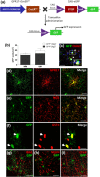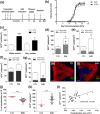Differential local tissue permissiveness influences the final fate of GPR17-expressing oligodendrocyte precursors in two distinct models of demyelination
- PMID: 29424466
- PMCID: PMC5900886
- DOI: 10.1002/glia.23305
Differential local tissue permissiveness influences the final fate of GPR17-expressing oligodendrocyte precursors in two distinct models of demyelination
Abstract
Promoting remyelination is recognized as a novel strategy to foster repair in neurodegenerative demyelinating diseases, such as multiple sclerosis. In this respect, the receptor GPR17, recently emerged as a new target for remyelination, is expressed by early oligodendrocyte precursors (OPCs) and after a certain differentiation stage it has to be downregulated to allow progression to mature myelinating oligodendrocytes. Here, we took advantage of the first inducible GPR17 reporter mouse line (GPR17-iCreERT2 xCAG-eGFP mice) allowing to follow the final fate of GPR17+ cells by tamoxifen-induced GFP-labeling to unveil the destiny of these cells in two demyelination models: experimental autoimmune encephalomyelitis (EAE), characterized by marked immune cell activation and inflammation, and cuprizone induced demyelination, where myelin dysfunction is achieved by a toxic insult. In both models, demyelination induced a strong increase of fluorescent GFP+ cells at damaged areas. However, only in the cuprizone model reacting GFP+ cells terminally differentiated to mature oligodendrocytes, thus contributing to remyelination. In EAE, GFP+ cells were blocked at immature stages and never became myelinating oligodendrocytes. We suggest these strikingly distinct fates be due to different permissiveness of the local CNS environment. Based on previously reported GPR17 activation by emergency signals (e.g., Stromal Derived Factor-1), we propose that a marked inflammatory milieu, such as that reproduced in EAE, induces GPR17 overactivation resulting in impaired downregulation, untimely and prolonged permanence in OPCs, leading, in turn, to differentiation blockade. Combined treatments with remyelinating agents and anti-inflammatory drugs may represent new potential adequate strategies to halt neurodegeneration and foster recovery.
Keywords: G protein-coupled receptor; animal models; differentiation; multiple sclerosis; oligodendrocyte precursor cells.
© 2018 The Authors GLIA Published by Wiley Periodicals, Inc.
Figures







References
-
- Boda, E. , Viganò, F. , Rosa, P. , Fumagalli, M. , Labat‐Gest, V. , Tempia, F. , … Buffo, A. (2011). The GPR17 receptor in NG2 expressing cells: Focus on in vivo cell maturation and participation in acute trauma and chronic damage. Glia, 59, 1958–1973. - PubMed
-
- Calderon, T. M. , Eugenin, E. A. , Lopez, L. , Kumar, S. S. , Hesselgesser, J. , Raine, C. S. , & Berman, J. W. (2006). A role for CXCL12 (SDF‐1alpha) in the pathogenesis of multiple sclerosis: Regulation of CXCL12 expression in astrocytes by soluble myelin basic protein. Journal of Neuroimmunology, 177, 27–39. - PubMed
-
- Ceruti, S. , Viganò, F. , Boda, E. , Ferrario, S. , Magni, G. , Boccazzi, M. , … Abbracchio, M. P. (2011). Expression of the new P2Y‐like receptor GPR17 during oligodendrocyte precursor cell maturation regulates sensitivity to ATP‐induced death. Glia, 59, 363–378. - PubMed
-
- Ceruti, S. , Villa, G. , Genovese, T. , Mazzon, E. , Longhi, R. , Rosa, P. , … Abbracchio, M. P. (2009). The P2Y‐like receptor GPR17 as a sensor of damage and a new potential target in spinal cord injury. Brain: A Journal of Neurology, 132, 2206–2218. - PubMed
Publication types
MeSH terms
Substances
LinkOut - more resources
Full Text Sources
Other Literature Sources
Molecular Biology Databases

